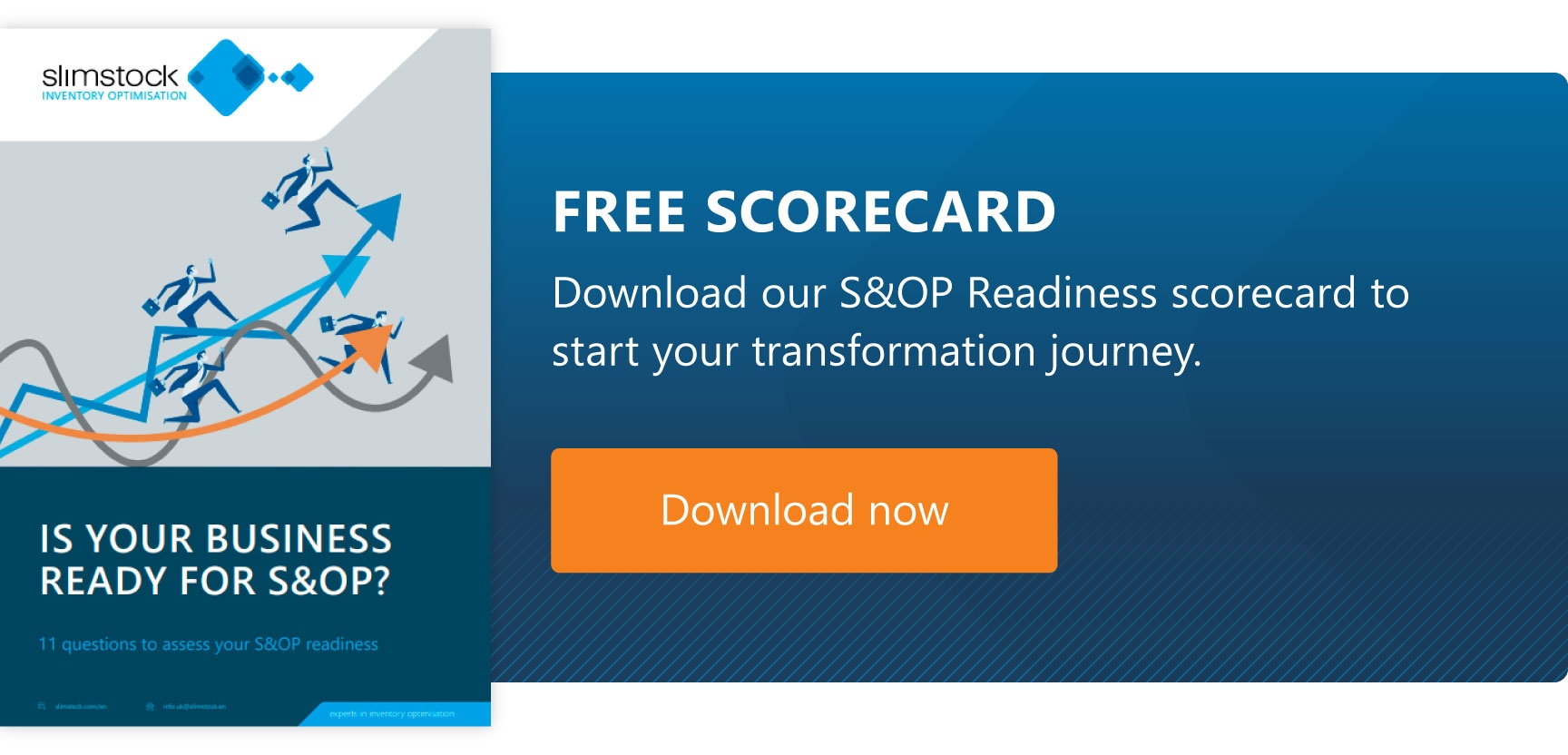Table of contents
Table of contents- Scenario Planning: An essential piece in the S&OP puzzle
- What is scenario planning, and what is its role in the S&OP process?
- Scenario planning: a real example
- Scenario Planning – Examples of possible scenarios and risks
- Why is scenario planning important, and why should it be part of the S&OP?
- Scenario planning: an effective tool to mitigate risks
- Scenario planning FAQs
I have worked professionally in the supply chain sector for 20 years and have been a Formula 1 fan for about ten years. I have seen how similar elite motor racing and a good S&OP process are during this time.
They have many aspects in common. First, a very well-defined governance, where responsibilities are very clear. Trackside teams, mechanics, strategy teams, factory teams, engineers… They are all very clear about what they are accountable to.
Then, there is an apparent differentiation in tactical and strategic planning. This means that strategists are concerned with the long-term vision for the following seasons, while tacticians are concerned with making adjustments to improve performance in the upcoming races.
Another essential element is that both are dependent on effective cross-functional collaboration.
Furthermore, in Formula 1, all decisions are backed by data. The amount of data to be analysed is enormous. Each car generates a million data points per second that need to be processed on any given race day. In the case of S&OP, this should also be the same input level, although, as we know, this is only sometimes the case.
Last but not least, the relevance of scenario planning must be addressed. In the case of F1, scenario planning goes far beyond the pit stop strategy, considering the possible actions that can be taken and the outcome of those actions. Data such as tyre degradation, tarmac temperature, weather, and insights from the competition shape the scenarios.
And all this is nothing more than S&OP in action. If F1 can do it once a week in a highly competitive environment, business has no excuse.
What is scenario planning, and what is its role in the S&OP process?
Scenario planning is a method that, through creative thinking, creates hypotheses about complex and uncertain futures in supply chain planning. It involves designing “future state” scenarios and formulating questions and possible answers to operate under each scenario. It consists of 4 steps:
1) Selecting the main question
The first step in building scenarios is to identify the main question. We want to identify a problem or opportunity to analyse through this question.
2) Identify drivers
Drivers are internal or external factors that will impact the business environment in which the organisation operates and, consequently, will condition the future dynamics of the supply chain. They can be trends or uncertainties that need to be developed.
3) Develop scenarios
Once a complete list of drivers has been identified, the next step is to reduce the list to two groups of the most relevant factors that can answer our main question. Each of these two broad groups will become our main uncertainty scenarios.
4) Communicate the implications of each scenario
The last step in scenario planning is to identify how the organisation will behave depending on the scenario and what decisions should be taken in each situation. Within the framework of an S&OP process, these strategic decisions are made during the monthly executive meeting.
Scenario planning: a real example
Let’s bring all this down to the real world and look at an example. A large electronics retailer was considering whether to enter the Indian market by launching a new network of stores.
Six months earlier, the business began working with an accelerated growth scenario of 25-45%, but it was also considering the possibility of new legislation affecting it. Therefore, the axes of uncertainty comprised the expected economic boom in the market and the regulatory framework.
Eventually, the Indian authorities enacted a new regulation raising tariffs on electronic goods, which increased costs and passed them on to consumers. As a result, demand in India fell while demand in other countries – such as Dubai, Thailand and Singapore, where Indian citizens shopped – grew. Thus, from a booming market, demand was weakened.
This is where scenario planning can help. Obviously, it is impossible to completely mitigate risk because forecasts will never be 100% accurate, but contemplate these different scenarios and prepare for possible responses.
Scenario Planning – Examples of possible scenarios and risks
The above example of declining demand due to regulatory changes is just one example of a possible scenario and its consequences. But there are many more.
Depending on the company’s circumstances, these factors generate growth scenarios or limit growth. Let us look at some of the most common scenarios that organisations must face.
| Growth scenarios according to: | |||||||
|---|---|---|---|---|---|---|---|
| Market | Product | Capacity | External Factors | ||||
| Entering a new market(s) | Launching a new brand | Capacity increase | Weakening of a competitor | ||||
| Starting a new project | Introduce new product categories | New production lines | Market exit of a competitor | ||||
| Expanding the customer base | Adding new product lines | Faster transport | A new supplier with better prices | ||||
| Creating new sales channels | Introducing new products | Extra resources | Customer Growth | ||||
| Contraction scenarios according to: | |||||||
|---|---|---|---|---|---|---|---|
| Market | Product | Capacity | External Factors | ||||
| Leaving a market | Cannibalisation | Maintenance of production lines | Change in consumer expectations | ||||
| Starting a new project | Product substitution | Capacity reduction | New competitor | ||||
| Rethinking a project | Product/brand discontinuity | Longer delivery times | Increased cost of goods | ||||
| Temporary closures | Product Quality Issues | Port congestion | Technological disruptions | ||||
On the other hand, some of the main risks companies have to face are:
| Contraction scenarios according to: | |||||||
|---|---|---|---|---|---|---|---|
| Geopolitical | Macroeconomic | Other | |||||
| New regulations | Inflation | Lack of manpower | |||||
| Changes in governments | Stagnation | Transport strikes | |||||
| State-driven sanctions | Recession | Changes in currencies | |||||
| Social unrest | Rising interest rates | Natural disasters | |||||
Why is scenario planning important, and why should it be part of the S&OP?
But is it essential to plan for future scenarios that will likely never materialise? The answer is yes. I will give you five reasons why it is necessary to integrate scenario planning into your S&OP process.
1) VUCA is the new normal
The VUCA (volatility, uncertainty, complexity, and ambiguity) environment has taken over recently. Since COVID-19, the supply chain has been suffering from a double problem of post-traumatic stress and paranoia. This means that we are still recovering from the trauma of COVID-19, and, at the same time, we are apprehensive about where the next “black swan” will come from.
Nothing can be preceded with 100% certainty, but having scenarios on the table can help us adapt more quickly.
2) Very intense competition
In today’s environment, all competitors are playing hardball. For example, Lululemon arrived only 3-4 years ago in the sports shoe industry and has taken a big bite out of Nike and Adidas’ business. This teaches us that competition can come from anywhere without us expecting it. Scenario planning allows us to focus on the threat to which our business is exposed.
3) Accelerated innovation
Like competition, innovation – and the speed at which it occurs – is also very intense. The business management literature is replete with examples of companies that put innovation on the back burner, and that decision was the reason for their decline. The case of Kodak – which led its segment for 80 years and was wiped out by digital camera technology – or Nokia and Blackberry – annihilated by smartphones – are two of the best-known examples. So, how your organisation manages innovation can be either an opportunity or a risk.
4) Legal context and regulatory framework
The legal context in a market can change from one day to the next. Let me give you an example I know well: last year in Dubai, the government changed the weekend from the traditional Friday and Saturday to the more western Saturday and Sunday. Imagine you are a food and consumer products retailer forecasting demand multiple times daily. Consumer habits from Friday and Saturday suddenly shift to Saturday and Sunday. This will inevitably have a significant direct impact on forecasting and inventory allocation.
5) Geopolitical risks
They are very much on our minds now, with two very hotly debated: the war in Ukraine and the Middle East. We never know when a new conflict may break out and directly affect our supply chain, so we must be prepared for whatever comes our way.
Scenario planning: an effective tool to mitigate risks
It is always tricky to predict the future. However, integrating scenario planning into your S&OP process will help you reduce all risks that may occur in the future. It will also allow you to take advantage of growth opportunities for your business.
Scenario planning FAQs
In the supply chain, what is scenario planning?
In the supply chain domain, scenario planning refers to the methodology that involves identifying and assessing possible future situations and their impacts. Various scenarios are anticipated, considering changes in demand, supply chain disruptions, economic fluctuations, or unforeseen events. This strategic approach allows companies to prepare for contingencies, optimise resources and make informed decisions.
How does scenario planning fit into the S&OP process?
Scenario planning is crucially integrated into the S&OP process by providing a strategic and anticipatory view. Within S&OP, scenario planning enables the assessment of various future scenarios in terms of demand, supply and other vital factors. By considering multiple possibilities, S&OP with scenario planning optimises the supply chain’s resilience, preparing it to respond effectively to changes and challenges, thus contributing to a more agile and efficient process.
What are the differences between forecasting and scenario planning?
Forecasting and scenario planning serve different purposes, and their effectiveness depends on the context and objectives. Forecasting involves predicting future outcomes based on historical data and trends, providing a single most likely scenario. It is effective for stable environments with relatively predictable variables. On the other hand, scenario planning explores multiple future possibilities, anticipating diverse outcomes and allowing for strategic adaptation. It excels in uncertain and dynamic situations.
What are the main benefits of scenario planning?
Scenario planning brings essential benefits to business management. It allows for anticipating uncertainty, building resilient plans, and optimising resource allocation. It facilitates informed decision-making by considering various scenarios, improving adaptability, and preparing organisations for the unpredictable.







